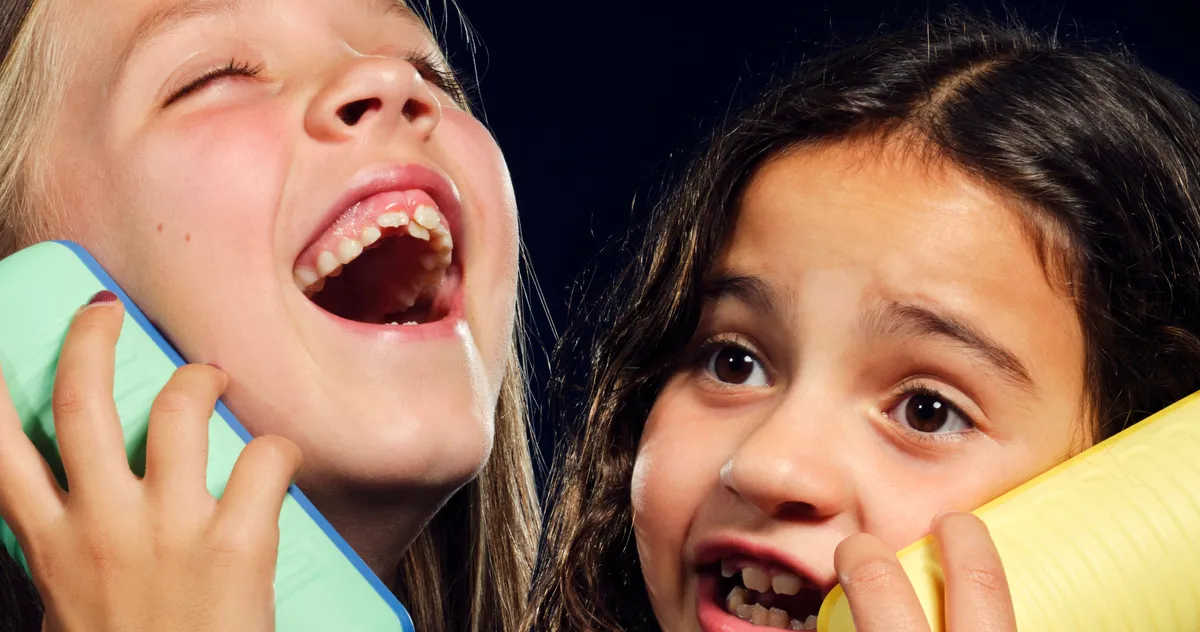
One of the hottest topics of conversation among parents right now is what to do about kids and phones. Increasingly, these conversations are dominated by stories of brave families who’ve gone old-school and gotten a landline instead of caving to the pressures of buying their kid an iPhone or a smartwatch. Now, there’s a company called Tin Can, the entire business model of which revolves around a landline phone designed specifically for children.
Tin Can’s promise is to sell you a phone that’s easy to set up (no dealing with Comcast or Verizon), affordable, and equipped with modern conveniences such as parental controls that let you approve contacts and schedule daily “quiet time.” The brand’s aesthetic leans heavily on the kind of ’80s and ’90s nostalgia millennial parents are so often drawn to — a curly-twirly phone cord, punchy pastel colors, and a retro dring dring of a ringtone.
But the minimal features are what could make it a game changer for kids who have grown up communicating exclusively via apps like FaceTime and Zoom on smartphones, smartwatches, and tablets that specialize in distraction. At first glance, Tin Can phones are not much different from the lo-fi landline I used at home as a kid. They have to be plugged into an outlet, forcing users to stay mostly in one spot and focus on the conversation at hand (perhaps while doodling on a nearby notepad). But instead of analog telephone service connected via copper wire or fiber-optic cables, they use your home internet service to make calls and are managed via an app. According to the brand, tens of thousands of parents have already bought into the Tin Can universe, with some families creating Tin Can “pods” to earn discounts on the phone itself and guarantee their kids will have a built-in Rolodex of friends ready to chat.
New! You can now save this product for later.
Tin Can
$75
$100 now 25% off
$75
New! You can now save this product for later.
To get a better sense of how the Tin Can differs from other landline phones, whether it’s a viable replacement for smartphones and -watches, and to generally discover what all the hype is about, I spent a month testing one alongside Strategist senior editor and fellow parent Jen Trolio. We each used our Tin Can phones for business and pleasure, conducting editorial meetings over them and teaching our kids how to dial numbers, pick up when it rings, leave a voice-mail, say good-bye before hanging up, cradle the handset between their chin and shoulder, and slowly twirl the cord around their fingers. Here’s what we learned.
For people who already like the idea of a landline, the Tin Can is exciting because it lets you avoid dealing with traditional service providers that often cost more and don’t have the same quality of customer service. Strategist lead editor Lauren Levy recently bought a retro pink lips phone to set up for her 5-year-old daughter, Lily. But then Verizon quoted her $30 a month to add a landline to her Fios service, which already costs $50 a month. “I just can’t bring myself to nearly double my bill just for that, but Lily is asking me regularly when we can get her house phone to work, so I am desperate for solutions,” she says.
Setting up the Tin Can is simple and straightforward. You order the phone online, and once it shows up, you download an app, scan a QR code, and follow a set of prompts within the app to get it working. Technically, the only thing you need to buy is the hardware, which currently costs around $75. With that, you can call for free anybody else who has a Tin Can phone: Each one is assigned a five-digit number for “Can 2 Can” calling within the Tin Can network.
But assuming you also want to use the Tin Can to call a grandparent’s cell phone, order a pizza, or let the math tutor know you’re running late, you’ll need to pay for the brand’s “Party Line” plan, which lets you add unlimited external numbers to your contact list for an additional $9.99 a month, less than the cost of Netflix. Both plans will let you call 911; you just have to enable emergency calling in the app and register your phone to a specific street address.
What makes the Tin Can feel modern are its built-in parental controls, like what you might see in a smartphone app but applied to an old-school device. Trolio and I both have the Tin Can app on our iPhones, which we use to manage approved contacts as well as the hours the phone can be used. Only the numbers we add to our contact lists can actually call in to our phones — good-bye, annoying spam and robocalls! — and by extension, those are the only numbers anyone in our households can call. Managing the contact list and providing the numbers for kids to dial takes a bit of time, but it’s a small tradeoff for the amount of freedom you can give them to use the phone as they please. Trolio’s younger daughter, who is 7, wanted to know if she had to ask before making a phone call. “She was so excited when I told her that no, she doesn’t,” says Trolio.
The “quiet time” setting in the app lets you schedule times when you don’t want the phone to ring. You can set it to either shut off or send calls to voice-mail during the same hours every day, say between 8 p.m. and 8 a.m. Or you can use the app’s advance schedule to set different quiet-time hours for different days of the week. You can also set the phone to “do not disturb” at any time in the app. There’s an official call log, too, in case you need to check who’s been calling in or who’s being called.
Anybody who has a working Tin Can phone right now, including myself and Trolio, has the original phone Tin Can offered, which the brand calls the Flashback. The hardware is not a new design; it’s a Trimline phone and has been around for decades. The Flashback comes in three colors — black, off white, or pink — and to set it up, you need a small adapter called “the brain,” which comes with the phone and plugs directly into your internet router. (As long as you have the brain, if you wanted to, you could use any other RJ11-compatible landline phone; even a novelty hamburger phone or frog phone would work.)
Initially, I set mine up using the free Can 2 Can service, which was very easy and took about 30 minutes. But then I upgraded to the Party Line plan, which ultimately required help from customer service. (Tin Can is still a very small company with fewer than ten employees, but the customer service is personal and miles away from what you would get calling Verizon.) Both Trolio and I like the grandma-esque design of the Flashback, but because it’s an old phone design, there’s no speakerphone option, and assigning speed-dial numbers or changing the ringtone is a clunky process. Recording an outgoing voice-mail message and checking messages are a bit easier, though: Just dial *97 and follow the prompts.
The main potential downside of the Flashback — and the biggest difference between it and the new Tin Can that is expected to start shipping this fall — is that the Flashback has to be physically connected to your internet router. That means Trolio’s phone is currently set up in her laundry room because that’s where the router is.
The newer Tin Can is modeled after and shaped like an actual can, complete with a nod to the ridges you’d find under the label of a can of baked beans or chicken soup. It comes in four pastel colorways and uses Wi-Fi instead of an Ethernet connection, with all the tech housed inside the phone so you don’t need the “brain” adapter. You do still have to plug it into a power source, however, which Tin Can founder Chet Kittleson says is intentional: “It’s very important that kids learn how to communicate using their voice, and being able to focus in one stationary spot is profoundly helpful for that. One of the most consistent pieces of feedback we get from families is they are just blown away by how much better their kid can converse on this device than on a FaceTime call.”
Still, the new model can live anywhere with a power outlet that your Wi-Fi signal reaches. You can have two Tin Can phones with two phone numbers plugged into power outlets in two different siblings’ rooms, and both can use the same household Wi-Fi. You can also have two Tin Can phones that share the same number, and both will ring when that number is dialed (they can even be installed in multiple houses, which is particularly useful if you’re a kid who goes back and forth between homes). The new Tin Can phone also has cute shortcut buttons for voice-mail and speed dial: A brand-logo button flashes when you have a voice-mail, and four emoji-labeled speed-dial buttons can be programmed with your favorite numbers.
Right now, the biggest downside of the new model (aside from its lack of retro styling) is that it’s preorder only and multiple preorders have already sold out. If you bought one during the first preorder period, it should arrive by November. If you order now, it won’t arrive until closer to Christmas.
I am thrilled to be introducing my 2-and-a-half-year-old son to a landline this early in his life. And I am hopeful it will encourage resourcefulness and help him practice social skills. That said, at the moment, he’s interested in using the phone only in short spurts and can do so only with my help. We have successfully called his grandparents, but he’s still learning what a landline phone is on the most basic level. Similarly, Strategist writer Martha Tuber told me that using the phone has been slow going with her 4-year-old daughter, who “is easily distracted and regularly puts the receiver down mid-call and just walks away,” Tuber says.
Meanwhile, Trolio’s 7-year-old, Nora, is delighted with the phone and even made her own directory with a drawing of her pink Tin Can Flashback on the cover. “She called my dad last night just to say ‘goodnight’ before bed, and before school this morning just to say ‘hi.’ She’s got his number memorized, can do the whole thing herself, and is young enough that the novelty of just calling a few special family members is so cool,” Trolio says. She’s also learning basic phone etiquette like how to leave a voice-mail and what to say to a friend’s mom if they pick up the phone when she calls. “The biggest draw is definitely the possible freedom and access,” she adds.
Trolio is still figuring out the best way to use the Tin Can with her 10-year-old daughter, who technically already has a phone number of her own because she has an Apple Watch but isn’t allowed to text with friends or give out the watch number for calls. Trolio says she’s not necessarily opposed to adding her daughter’s friends’ Apple Watch phone numbers to the Tin Can contact list so her daughter can call a friend’s watch from the Flashback. But for the time being, she’s waiting to see how things pan out when several families in her city who preordered the new Tin Can get theirs.
Tin Can’s biggest selling point right now is its virality. This spring, the start-up secured enough funding to buy ads on Instagram, helping it garner an impressive amount of nationwide traction. Parents who’ve already bought in desperately want Tin Can phones to catch on because the more families who opt in, the more likely it is the landline universe will take off.
Perhaps most crucially, kids have to want to use it. Older kids may groan at first or be embarrassed to give out their Tin Can number to friends because there’s no texting. Since it’s new and there’s a social learning curve to using a landline, it may take time before they are all in on the idea. That’s a big part of why some groups of parents are banding together and buying the phones in “pods.”
Where Trolio lives, the families who’ve preordered are excitedly waiting for the new Tin Cans to arrive. “I think the ecosystem will ultimately bloom. There is talk of putting together a little directory for all these fourth-grade girls so they have one another’s numbers at a glance. But it’s a slower start for that age group due to not everyone having the actual hardware yet and figuring out who can call whom,” she says.
For now, Tin Can phones work only within the United States and Canada. They’re also Wi-Fi only and need a power source, so if your internet or electricity goes out, the phone won’t work. And as a parent, you still have to be willing to manage your kid’s contact list and set them up with a way to organize the numbers they’ll need when they want to make a call. If you don’t want to constantly read out phone numbers, kids will have to memorize the most important ones or compile some sort of Rolodex. It’d be nice if Tin Can made one, actually.
The Tin Can isn’t a replacement for a smartphone or an Apple Watch. But for families hoping to delay giving their kids a cell phone as long as possible, it gives kids a screen-free way to connect with their friends independently and lets them make plans without borrowing a parent’s cell phone or relying on someone else to do it all for them. It also chips away at the problem of kids who may feel left out of social situations because they don’t have a phone, tablet, or watch to communicate with. Trolio especially appreciates that the Tin Can lets kids call one another and talk but in a way that’s more “out in the open” than if they were in their bedrooms texting.
It’s also an investment in better social skills and etiquette, giving kids a way to practice talking on the phone without a written record of everything they’ve ever said. And just as a landline did when I was a kid, it helps build the confidence needed to meet and talk to people you don’t already know. I’ve interviewed so many parents and educators who say tweens, teens, and even college students these days are afraid to make simple calls to check a store’s hours or make a doctor’s appointment. Those tasks are a lot less scary if you get used to calling people when you’re young.
More From The Strategist
I’m Extremely Picky About My Pens. After Years of Testing, I Have 10 Favorites.
So You’re Looking to Outfit Your Kitchen From Scratch …
The Strategist Fall 100
What Sally Jessy Raphael Can’t Live Without
See All



